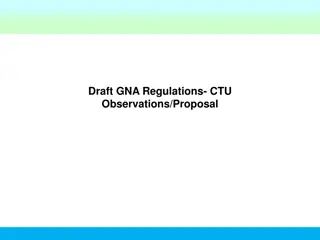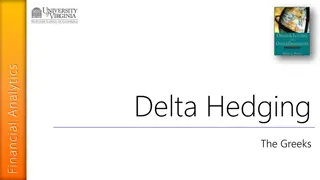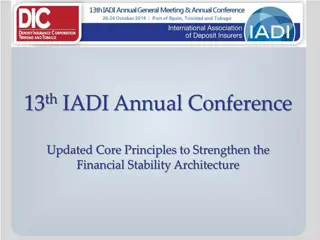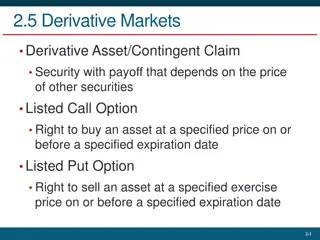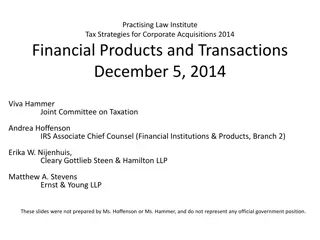Effectiveness of Derivative Products in India for Hedging Investment Guarantees of Life Insurers
This seminar explored the use of derivative products in India to hedge investment guarantees of life insurers, along with challenges in pricing cyber and terrorism risks. It covered the history of life insurance in India, types of products, investment guarantees, and the role of derivatives in managing risks effectively.
Download Presentation

Please find below an Image/Link to download the presentation.
The content on the website is provided AS IS for your information and personal use only. It may not be sold, licensed, or shared on other websites without obtaining consent from the author.If you encounter any issues during the download, it is possible that the publisher has removed the file from their server.
You are allowed to download the files provided on this website for personal or commercial use, subject to the condition that they are used lawfully. All files are the property of their respective owners.
The content on the website is provided AS IS for your information and personal use only. It may not be sold, licensed, or shared on other websites without obtaining consent from the author.
E N D
Presentation Transcript
27th India Fellowship Seminar Effectiveness of Derivative Products in India to Hedge Investment Guarantees of Life Insurers Cyber risk and Terrorism risk - Challenges in pricing Guide: Rajagopalan V. Supervisor: P.A. Balasubramanian, FIAI Presenters: Rakesh Kumar Ranjan Gupta Prasham Rambhia 1st June 2017 Mumbai Indian Actuarial Profession Serving the Cause of Public Interest
Agenda Life Insurance in India Investment Guarantees of Life Insurers in India Derivatives and their Broad Types Derivatives: Indian Context IRDAI Regulations and Guidelines Interest Rate Swaps Interest Rate Futures Use of Derivatives by Overseas Life Insurers Conclusion
Life Insurance in India Brief History of the Sector Nationalization of life insurance sector in 1956, all existing entities merged into a single public sector firm: Life Insurance Corporation of India Privatization of sector in 2000; establishment of regulatory body (IRDAI) Currently, 24 life insurers in India (1 in public sector, 23 in private sector) Categories of Products Non-participating Participating Term insurance policies Whole life policies Money back policies Endowment policies Child plans ULIPs Pension plans
Investment Guarantees of Life Insurers in India Product Type Investment Guarantee Comments Pure insurance product, no investment component Insurance-investment hybrid; more risky for non-participating product Investment risk borne by policyholder Extent of risk depends on specific type of annuity Term insurance None Whole-life / Money-back / Endowment policies Child plans Returns often guaranteed; hence, insurer bears (mostly interest rate) risk ULIPs None Implied guarantee on interest rates Annuity/pension plans Guarantees are relevant for both non-participating and participating products: Non-participating products Guaranteed return Participating products Guarantees accumulate with every declared bonus Also, there is need to meet Policyholders Reasonable Expectations Interest rate risk is the key investment risk factor for life insurers Other risks might include equity, credit, currency (FX) risks
10 Year Indian Government Bond Yield Falling yield Risk of not meeting the investment guarantees Creates the need for derivatives to hedge the interest rate risk
Derivatives and Broad Types Derivatives = Securities which derive their value from other, more fundamental underlying assets or variables Common Derivative Types Futures/Forwards (exchanging cash/asset in future on previously set terms) Swaps (exchange of series of payments according to pre-decided formula) Options (right, but no obligation, to enter in a pre-decided transaction in future) More complex versions (swaptions, compound options, etc) Derivative Markets Exchange Traded (standardized, liquid, very little default risk) Over The Counter (customized/bespoke, flexible, prone to default risk) Common Underlying Assets/Variables Equities / Currency (FX) / Interest Rates (IR) / Credit / Commodities
Examples/Types of Derivatives Exchange-traded OTC Futures Options Forwards Options Swaps Equities Index Futures Index options Repurchase Agreement Stock Option Equity Swap FX Currency Future Option on Currency Future Option on Eurodollar Future Option on Bond Future Currency Forward Currency Option Currency Swap IR Eurodollar Future Forward Rate Agreement (FRA) Repurchase Agreement IR Caps and Floors, Swaption Default Option Interest Rate Swap (IRS) Credit Bond Future Credit Default Swap (CDS) Commodities Crude Oil Future Copper Option Livestock Forward Gold Option Commodity Swap
Derivatives: Indian Context Relatively Nascent RBI first permitted IR derivatives (FRA/IRS) in July 1999 Equity index futures launched in June 2000 (Options followed in June 2001) FX futures trading on NSE went live in August 2008 First credit derivative (CDS) traded in December 2011 Highly Regulated (compared to developed financial markets) Underlying Asset Class IR / FX / Credit Equity / Commodity Regulator Reserve Bank of India (RBI) Securities Exchange Board of India (SEBI) For many derivative types, particularly OTC, there are stringent regulations such as: Naked positions not allowed / Need to hedge must be demonstrated Only a few, highly regulated entities can play market-maker Restrictions on participation of foreign and non-resident players
Derivatives for Life Insurers in India Use of derivatives by life insurers is relatively subdued because: Derivatives market in India is not very deep Insurers in India have severe regulatory restrictions (imposed, directly or indirectly, by several sources) on their use Successful adoption would require the following elements: specialist expertise shared understanding of risks between executives and the Board appetite for use of derivatives and relevant governance norms The key investment risk factor for life insurers is Interest Rates! Therefore, in practice, the most commonly used derivatives include: Interest Rate Swaps (IRS) Interest Rate Futures (IRF)
IRDAI Regulations (Derivatives) Dealing in financial derivatives Section 11 (IRDAI Investment Regulations 2000): Dealing in Financial derivatives is permitted in accordance with the guidelines issued by the Authority from time to time IRDAI Guidelines (2004): Permitted use of derivatives with a maximum tenure of 1 year to hedge the interest rate risk on investments and forecasted transactions which had limited use for life insurers Circular (11th June 2014) Guidelines on Interest rate derivatives: Guidelines to deal with interest rate derivatives with longer terms IRDAI (Investment) Regulations, 2016: Exposure/ Prudential and other investment norms to be complied with while dealing in derivatives
Guidelines on Interest rate derivatives 3 types of Interest rate derivatives are permitted: Interest rate swaps (IRS) Interest rate future (IRF) Forward rate agreements (FRA) Hedging permitted for forecasted transactions: Maturity proceeds of fixed income securities Investment income Expected premium receivables for underwritten insurance contracts Can be used for hedging only Counterparties need to be commercial bank or primary dealer permitted by RBI Two-way CSA (Credit Support Annex) agreements mandatory to mitigate the counterparty risk Credit Equivalent Amount of the FRA/IRS to be used for reckoning counter party credit exposure
Guidelines on Interest rate derivatives Restriction on total exposure specified (notional principal amount equivalent to 100% of the book value of the fixed income investments of the insurer under the policyholder s fund (excluding ULIP ) and shareholders fund taken together) Pre-approved risk management policy by the board of directors Board to ensure the suitability and appropriateness of the investments Efficient corporate governance, where the board and the insurer know the complex products and the risks involved Quarterly reports to be submitted to IRDAI in the prescribed format Certificate from the concurrent auditor that systems and procedures are in place Compliance with RBI, ISDA guidelines & Accounting standards
Accounting Standards Requirement Fair Value Hedge: Hedge the fair value of the underlying item. Any loss/gain from re-measuring the derivative at fair value is recognised in P/L account Cash Flow Hedge: Hedge of the exposure to variability in cash flows Treatment in Balance Sheet : Effective portion is recognized directly in the separate reserve called Hedging Reserve in Reserves and Surplus Treatment in P/L Account : Ineffective portion of the fair value movement on derivative is recorded Hedge Effectiveness Test: should lie between 80% and 125%
Interest Rate Swaps An Interest Rate Swap (IRS) is a derivative instrument in which two parties agree to exchange interest rate cash flows, based on a specified notional amount from a fixed rate to a floating rate (or vice versa) or from one floating rate to another IRS was introduced in 1999 to enable market participants to hedge interest rate risk RBI has only allowed plain vanilla IRS products to be offered Fixed rate Investment Bank Insurance company Floating rate Floating rate Fixed Assets Liability
Interest Rate Swaps RBI has not prescribed use of any particular floating rate benchmark, Currently three benchmarks are commonly used in IRS: MIBOR: daily overnight Mumbai Inter-Bank Outright Rate MIFOR: Mumbai Inter-Bank Forward offered Rate which a mix of the London Interbank Offer Rate (LIBOR) and a forward premium derived from Indian forex markets. INBMK: Indian government securities benchmark rate INR in Crores Source: CCIL s Rakshitra, April 2017
Advantage and Disadvantage of IRS Advantage: Removes uncertainty about interest rate Customized as per ones requirement Fairly Liquid market up-to 5 year period Disadvantages : Basis risk if the spread between G-sec and MIBOR is wider Require rebalancing in light of mortality & persistency experience Illiquidity for longer tenure Counterparty risk Volumes declining over last few years Documentation and compliance cost
Interest Rate Futures An Interest Rate Futures contract is "an agreement to buy or sell the underlying debt instrument at a specified future date at a price that is fixed today Objective: To allow hedge of interest rate risk in a market environment, where long term debt issuance by the government is increasing Exchange traded interest rate derivatives were introduced in 2003 but failed due to prohibition on banks to trade complex cash settlement mechanism Reintroduced in 2009 but failed due to physically settlement and illiquidity in the underlying bond the bank participation was low due to OTC attractiveness Introduced for the 3rd time in January 2014 Allowed cash settlement Introduced at 3 exchanges viz. NSE, BSE and MCX-SX Daily average turnover in the IRF segment is still very low
Advantages and Disadvantages of IRF Advantages : 10 Year G-Sec is the underlying Most Liquid Hedge against Long duration liabilities Less Basis Risk No counterparty default risk Comparatively less compliance cost Easier to rebalance in light of mortality & persistency experience Disadvantages: Possibility of Rollover risk Less Liquidity beyond 1 month Cannot offer a good hedge for all maturities Volumes yet to gain sufficient traction
Use of Derivatives by Overseas Life Insurers Equity Puts & Collars Used by large number of UK insurers to protect against equity value falls Options generally based on FTSE 100 as opposed to FTSE all shares, introducing basis risk Effectiveness could be evaluated in terms of mean and standard deviation of difference in FTSE 100 and FTSE All Monthly price movement Statistics for 5 years During Credit Crunch, wider price differences observed Not perfect hedge (diff of 10% on average) Fairly effective during the crunch time All share options reduce basis risk but are more costly and less liquid Source: SIAS Report of the Risk and Investment Working Party, April 2010
Use of Derivatives by Overseas Life Insurers Interest Rate Swaps Used by majority of UK insurers for: Matching guaranteed benefits under with-profits contracts Immunization from interest rate mismatch Duration matching of assets and liabilities Swap rates are traditionally higher than gilt yields, i.e. swap spreads are traditionally positive o o o Traditionally, Swap spreads stable (~30 bps) During credit crunch: short end swap spread increased long end swap spread declined, becoming negative Swap Spreads (%) Swap Rate minus Gilt Yield
Use of Derivatives by Overseas Life Insurers Interest Rate Swaps Contd.. Volatility in swap spread flows through Balance Sheet To illustrate the potential balance sheet impact, let s consider example of a rolling 30 year liability, valued using the 30 year gilt yield Two investment strategies considered: Liability backed with cash: exposed to movement in 30 year gilt yield Liability hedged with 30 year interest rate swap: exposed to 30 year swap spread o o Before credit Crunch, noticeable improvement in mean and volatility of net asset position During credit crunch, hedging increased the risk Movement in net assets for 30 year Liability
Use of Derivatives by Overseas Life Insurers Hedging Strategy for Variable Annuities (VA) in US VA involves number of different types of guarantees: GMDB, GMAB, GMIB, GMWB Guarantees valuable to policyholders during financial crisis Hedging adopted by most insurers worked as intended Hedging saved the industry $40 billion in Sep. and Oct. 2008, offsetting more than 90% of industry s increased liability over the period Most insurers reported breakage below 2% before 2008. In 2008, some insurers experienced double digit breakage (e.g. 30%) Reasons for hedge breakage include: basis risk, policyholder behavior, counterparty risk, execution risk
Use of Derivatives by Overseas Life Insurers Lessons Learnt Analyze hedging strategies in detail to understand basis and other residual risks Establish appropriate economic capital for basis risks Reflect in new business pricing the costs associated with basis risks between guarantees offered to customers and available hedging instruments Review selection of counterparties and their collateral, and other counterparty risk mitigation arrangements Perform stress tests of hedging strategies and collateral arrangements against extreme events including, but not limited to, a repeat of the financial crisis Ensure that the issues associated with basis risk are properly communicated to all key stakeholders (e.g. the Board)
Conclusion Available derivatives in India are helpful in mitigating investment guarantees to a limited extent Need to develop expertise, understanding and governance structure regarding use of derivatives Hedging through derivatives can give a competitive advantage Practical difficulties need to be overcome Risk management is required for residual risk Consideration need to be given to the effectiveness in a stressed scenario (e.g. financial market turmoil)
Wide Use of Swaps Worldwide JAPAN: The notional amounts outstanding of derivatives transactions Japanese financial institutions at end- December 2014 were equivalent to 54.3 trillion U.S. dollars for over-the-counter (OTC) contracts and 4.9 trillion U.S. dollars for exchange-traded contracts. A breakdown by instrument type shows that IR swaps continued to hold the largest share of accounting for 73.2 percent by major OTC contracts, USA: Forward rate agreements (FRAs), interest rate swaps, and interest rate options averaged $628 billion per day in the United States during April 2013.
Falling IRF Volumes IRFs are mainly used by the holders of government bonds. Government bonds were concentrated in the hands of commercial banks (35 per cent), insurance companies (21 per cent) and provident funds (7.58 per cent.) These institutions would be selling the instruments before the maturity date and they do not need IRF. Retail investors rarely hold government bonds directly & Mutual funds hold 1.89 per cent of the government bond issuances Foreign portfolio investors who hold 3.67 per cent are likely to churn their bond portfolio more often and hence, may need IRFs. Too many restrictions on the kind of strategies that these investors can adopt while trading. For instance, the total gross short (sold) position of each FPI in IRF shall not exceed its long position in government securities and in IRFs at any point in time. These rules limit the freedom in implementing trading strategies
Accounting Standards Requirement Disclosures in the Financial statements: Description of Participant s financial risk management objective and policies, in particular its policy for hedging forecasted transactions. Hedging strategy. Accounting Policy for Derivatives. Nature and terms of outstanding Interest Rate derivative contracts. Quantification of the losses which would be incurred if counter-parties failed to fulfil their obligation under the outstanding Interest Rate derivative contracts.
Interest Rate Swaps: MIBOR: reference rate equal to the daily overnight Mumbai Inter-Bank Outright Rate. Calculated everyday by the National Stock Exchange of India (NSEIL) as a weighted average of lending rates of a group of banks. The swaps on overnight MIBOR, i.e. OIS, is the most actively traded instrument. The OIS trades are mainly confined to 1-year tenor, followed by 2- year and 5-year tenors Overnight MIBOR 9 8.5 8 Rate % 7.5 7 6.5 6 Year 2016 MIFOR: rate for a Reset Date will be the Mumbai Inter-Bank Forward offered Rate for a period of the Designated Maturity. MIFOR is a mix of the London Interbank Offer Rate (LIBOR) and a forward premium derived from Indian forex markets. INBMK: rate for a Reset Date will be the Indian government securities benchmark rate for a period of the Designated Maturity.





